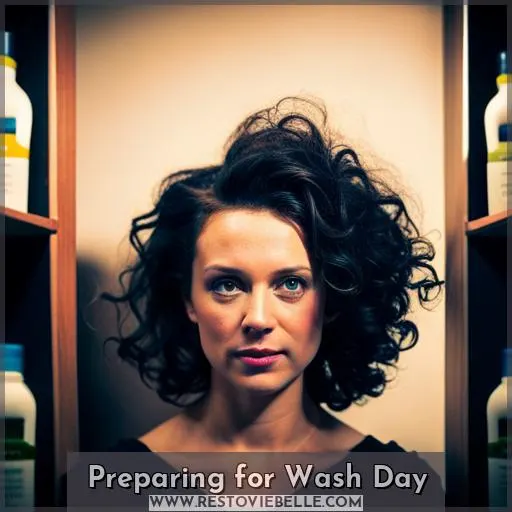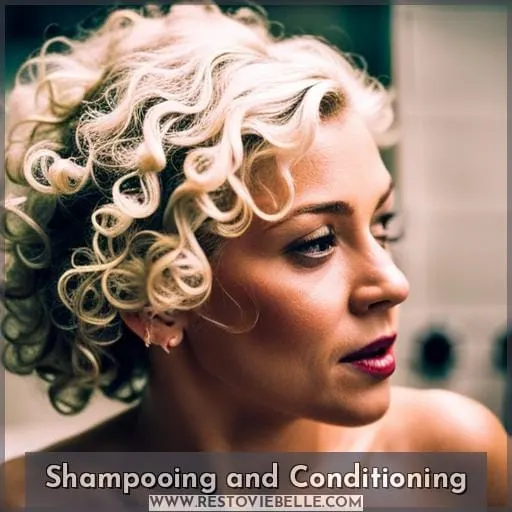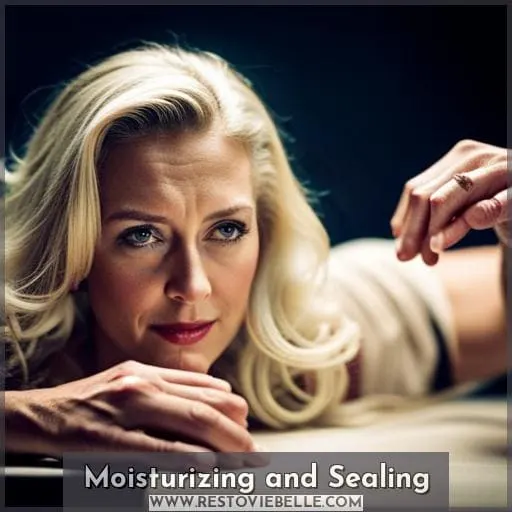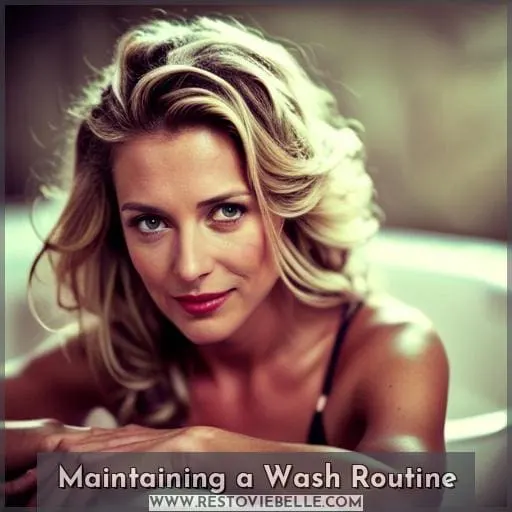This site is supported by our readers. We may earn a commission, at no cost to you, if you purchase through links.
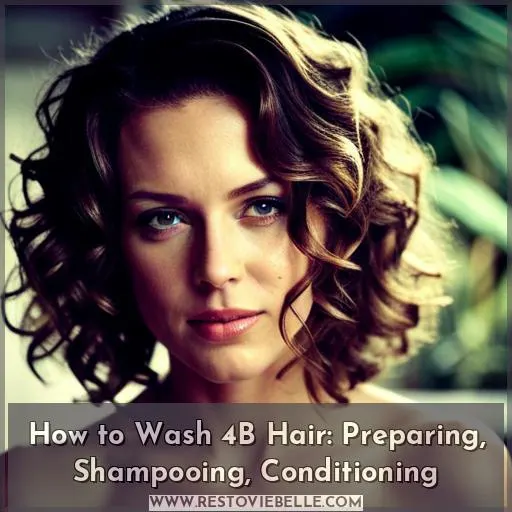 Ready to master the art of washing your 4B hair? In this guide, we’ll walk you through the essential steps to prepare, shampoo, and condition your beautiful curls.
Ready to master the art of washing your 4B hair? In this guide, we’ll walk you through the essential steps to prepare, shampoo, and condition your beautiful curls.
- Detangle effectively
- Choose the right products for your hair type
- Moisturize like a pro
Get ready to unleash the full potential of your 4B hair with our comprehensive wash routine!
Table Of Contents
Key Takeaways
- Section your hair into quadrants for systematic washing.
- Use gentle detangling methods and invest in quality detangling tools.
- Prioritize thorough cleaning and conditioning per section.
- Protect your hair during drying and overnight with satin/silk materials or methods.
Preparing for Wash Day
Before you begin washing your 4B hair, it’s important to prepare by detangling and sectioning your hair.
Detangle your hair using a wide-tooth comb or the Q-Redew handheld steamer for effective results.
Divide your hair into quadrants to make the washing process more systematic and efficient.
By preparing in this way, you’ll ensure that each section of your 4B hair is thoroughly cleaned and conditioned during wash day.
Detangling Hair Before Washing
Before washing your 4B hair, it’s important to detangle it thoroughly. Effective detangling is crucial for achieving tangle-free results and ensuring a smooth wash day routine.
- Utilize the quadrant method by dividing your hair into sections.
- Use moisturizing techniques, such as applying conditioner or using a steamer.
- Invest in quality detangling tools like wide-tooth combs or brushes with flexible bristles.
- Be gentle and patient when working through knots and tangles to avoid breakage.
Sectioning Hair for Efficient Washing
To effectively wash 4B hair, start by sectioning your hair for a more efficient washing process.
Divide your hair into sections using clips or bands to make it easier to work with and ensure that all areas are thoroughly cleaned. This method allows you to focus on one section at a time, making detangling and product application much smoother.
Whether you prefer wet or damp sections, find the technique that works best for you and enjoy a hassle-free wash day experience.
Efficient Sectioning
- Divide your hair into sections using clips or bands.
- This method allows you to focus on one section at a time.
- Makes detangling and product application much smoother.
Wet vs. Damp
- Some people prefer to wash their hair with wet sections, while others prefer damp sections.
- There is no right or wrong way, so find the technique that works best for you.
Detangling Techniques
- There are many different detangling techniques that you can use.
- Find one that works well for your hair type and texture.
- Be gentle and patient when detangling your hair.
Shampooing and Conditioning
To effectively wash 4B hair, start by using a sulfate-free shampoo that gently cleanses the scalp without stripping away natural oils.
Look for hydrating conditioners that provide moisture and help with detangling, as this hair type tends to be prone to dryness and knots.
Deep conditioning is crucial for added hydration, so choose a deep conditioner that nourishes and restores moisture to your 4B hair.
Using a Sulfate-free Shampoo
Start by gently massaging a sulfate-free shampoo into your scalp, allowing the suds to cleanse your hair strands.
Using a sulfate-free shampoo offers several benefits for 4B hair, including:
- Reducing dryness and frizz
- Preserving natural oils
- Preventing color fading
These shampoos are also gentle on the scalp and don’t strip away moisture from the hair.
Look for moisturizing ingredients like shea butter or coconut oil in sulfate-free shampoos to further enhance their hydrating impact.
Some recommended sulfate-free shampoos for 4B hair include:
- TGIN Moisture Rich Sulfate-Free Shampoo
- As I Am Coconut Cowash
Choosing a Hydrating Conditioner
Once you have cleansed your 4B hair with a sulfate-free shampoo, it’s time to move on to the next step of choosing a hydrating conditioner.
When selecting a conditioner for your 4B hair, consider factors such as:
- Product selection
- Ingredient considerations
- Detangling techniques
- Moisture retention benefits
- Proper application methods
A well-chosen hydrating conditioner will help nourish and moisturize your hair while minimizing breakage and promoting healthy growth.
Deep Conditioning for Added Moisture
After choosing a hydrating conditioner, the next step in washing 4B hair is deep conditioning for added moisture.
Deep conditioning provides a moisture boost and helps to restore hydration to dry, damaged hair.
You can enhance the deep conditioning process by using detangling techniques such as finger combing or using a wide-toothed comb to remove knots and tangles.
Consider incorporating steamer benefits or heat cap deepening for even better results.
Experiment with different product combinations like Cantu Coconut Curling Cream and utilize tools like a hooded dryer for an effective 4B wash day routine.
Drying Techniques
Now that you’ve finished washing and conditioning your 4B hair, it’s important to properly dry it to avoid damage or frizz.
After rinsing out the conditioner, gently squeeze out any excess water from your hair using a microfiber towel.
Then, you have two options for drying:
- Allow your hair to air-dry naturally.
- Use a blow dryer on a low-heat setting.
If you choose to use heat, remember to apply a heat protectant spray before drying for added protection against potential damage.
Gently Squeezing Out Excess Water
To continue the process of washing 4B hair, gently squeeze out excess water from your strands after rinsing out the conditioner.
Use a microfiber towel to absorb moisture without causing frizz or damage.
Avoid rubbing or wringing your hair, as this can lead to breakage and tangling.
Instead, lightly press and squeeze sections of your hair with the towel to remove water.
Consider using techniques like plopping or air-drying for additional moisture retention and reduced heat exposure.
Air-drying or Using a Low-heat Setting
To dry your 4B hair after washing, you can choose to:
- Air-dry
- Use a low-heat setting on your blow dryer.
Air-drying is a heat-free option that allows for gentle drying and minimal manipulation of the curls. Simply let your hair hang loose or style it in twists or braids for added definition while it dries naturally.
Alternatively, if you prefer using a blow dryer, opt for the low-heat setting to minimize damage and prevent frizz.
Remember to always use a heat protectant before applying any heat to your hair and consider protecting your curls overnight with satin bonnets or pillowcases for optimal results in styling without relying heavily on excessive heat usage.
Using a Heat Protectant if Using a Blow Dryer
If you’re using a blow dryer on your 4B hair, make sure to apply a heat protectant for added protection.
Here are some tips to follow when using a blow dryer:
- Choose the lowest heat setting possible.
- Keep the blow dryer at least six inches away from your hair.
- Use a diffuser attachment to distribute airflow evenly and prevent frizz.
- Section your hair and work in small sections for thorough drying.
- Take breaks between passes with the blow dryer to avoid overheating.
Moisturizing and Sealing
Now that your hair is clean and conditioned, it’s time to moisturize and seal in the moisture.
Applying a leave-in conditioner or moisturizer will help keep your hair hydrated throughout the day. Be sure to focus on the ends of your hair, as they’re typically drier and more prone to breakage.
After applying a leave-in conditioner or moisturizer, seal in the moisture with a lightweight oil or butter.
Applying a Leave-in Conditioner or Moisturizer
After thoroughly drying your hair, how should you maintain moisture and softness in your 4B curls?
Start by applying a hydrating leave-in conditioner or moisturizer like Shea Moisture’s leave-in to impart lasting moisture into each strand.
Opt for finger detangling when distributing the product to minimize breakage.
Focus on moisture retention by selecting ingredients that hydrate 4B hair.
Continue your nighttime care with protective styling.
These styling tips will keep your curls properly hydrated.
Sealing in Moisture With a Lightweight Oil or Butter
Once you’ve applied a leave-in conditioner or moisturizer, next seal in moisture by using a lightweight oil or butter.
Opt for oils like grapeseed or jojoba which penetrate strands without weighing hair down.
Apply sparingly, focusing on ends. Twist hair gently to encourage even distribution, sealing in the leave-in’s moisture.
Nighttime Protection
To protect your 4B hair overnight, consider using a silk or satin scarf/bonnet. These materials help to prevent friction and moisture loss while you sleep, keeping your hair moisturized and reducing breakage.
Another option is to use a silk pillowcase that provides similar benefits.
Additionally, there are various nighttime protection methods specifically designed for curly and coily hair types such as the pineapple method, plopping technique, or the bonnet method.
The pineapple method involves gathering all of your hair on top of your head in a loose ponytail resembling the shape of a pineapple before securing it with an elastic band or scrunchie.
Plopping entails gently placing damp hair onto a microfiber towel or T-shirt and wrapping it up to enhance curl definition while minimizing frizz during drying time.
Nighttime protection is essential for maintaining healthy 4B curls by preserving moisture levels and preventing damage caused by rubbing against rough surfaces like cotton pillowcases.
Maintaining a Wash Routine
Now that you have learned about the importance of nighttime protection for your 4b hair, it’s time to shift our focus to maintaining a consistent wash routine. Consistency is key when it comes to keeping your hair healthy and flourishing. To maintain your wash routine, consider factors such as hair porosity, moisturizing tips, scalp care, protective styling, growth techniques and products like Alikay Naturals Shea Yogurt or silicone-free conditioner.
Firstly, understanding your hair’s porosity will help determine how often you should be washing and conditioning.
you may need more frequent washes compared to low porosity individuals who retain moisture longer.
Additionally, maintaining a pre-wash routine can make a significant difference in preserving the health of your 4b strands. Pre-washing typically involves detangling with wide-tooth comb before shampooing or using water bottle misting technique which ensures optimal hydration levels are achieved prior cleanse.
Finally, don’t forget about protecting those beautiful curls while they dry by limiting excessive manipulation, twisting into loose buns or braids, and avoiding heat usage.
Frequently Asked Questions (FAQs)
How often should I wash my 4b hair?
To maintain healthy 4b hair, wash it every 1-2 weeks.
This frequency helps to balance moisture levels and prevent product buildup.
Adjust your washing schedule based on personal preference and the needs of your hair.
What ingredients should I avoid when choosing products for my 4b hair?
When choosing products, avoid those with:
- Sulfates
- Silicones
- Mineral oil
- Parabens
Focus instead on natural, nourishing ingredients like:
- Shea butter
- Coconut oil
- Aloe vera
- Honey
My 4b hair gets really tangled after washing. What can I do?
Detangle your 4b hair before shampooing with a leave-in conditioner to reduce knots.
Use a wide-tooth comb during the conditioning step to gently remove tangles from mid-length to ends.
Rinse thoroughly with cool water and gently blot dry with a microfiber towel to minimize further tangling and frizz.
I have a sensitive scalp. What kind of shampoo should I use for my 4b hair?
For your sensitive scalp and 4b hair, opt for a gentle shampoo that’s sulfate-free and formulated with soothing ingredients like aloe vera or chamomile.
Look for products specifically designed to nourish and hydrate the scalp while cleansing the hair effectively.
How can I reduce frizz when air drying my 4b hair?
To reduce frizz when air drying 4b hair,
- Use a microfiber towel or t-shirt to gently squeeze out excess moisture after washing.
- Apply a nourishing leave-in conditioner or curl cream,
- Then let hair air dry naturally instead of rubbing or rough drying.
Choosing products without harsh alcohols or sulfates will also help minimize frizz.
Conclusion
To truly unlock the potential of your 4B hair, mastering the art of washing is essential.
By following the steps outlined in this guide, you can ensure that your wash routine is effective and tailored to your hair type.
From detangling and sectioning to choosing the right products and moisturizing techniques, you’ll be equipped with the knowledge and skills to take care of your beautiful curls.
Embrace your 4B hair and achieve the healthy, hydrated results you deserve.
